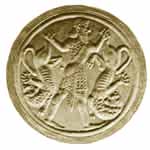|
Gilgamesh was an historical king of Uruk in Babylonia, on the River Euphrates in modern Iraq. He lived about 2700 B.C. Although historians tend to emphasize Hammurabi and his code of law, the civilizations of the Tigris-Euphrates area, among the first civilizations, focus rather on Gilgamesh and the legends accruing around him to explain, as it were, themselves. Many stories and myths were written about Gilgamesh, some of which were written down about 2000 B.C. in the Sumerian language on clay tablets which still survive. The Sumerian language, as far as we know, bears no relation to any other human language we know about. These Sumerian Gilgamesh stories were integrated into a longer poem, versions of which survive not only in Akkadian (the Semitic language, related to Hebrew, spoken by the Babylonians) but also on tablets written in Hurrian and Hittite (an Indo-European language, a family of languages which includes Greek and English, spoken in Asia Minor). The fullest surviving version is derived from twelve stone tablets, in the Akkadian language, found in the ruins of the library of Ashurbanipal, king of Assyria 669-633 B.C., at Nineveh. The library was destroyed by the Persians in 612 B.C., and all the tablets are damaged. The tablets actually name an author, which is extremely rare in the ancient world, for this particular version of the story: Shin-eqi-unninni. |

